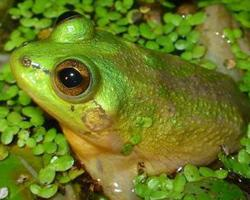
Váhy a míry
| Délka | 8 cm |
|---|
Stav ohrožení
| Ohrožen |
Popis zvířete
The Paradoxical frog, scientifically named Pseudis paradoxa, presents one of nature's most intriguing enigmas, embodying a fascinating paradox that perplexes and fascinates scientists and nature enthusiasts alike. This amphibian, native to the freshwater environments of South America, specifically in regions stretching from Venezuela, the Guianas, and Trinidad, down through Brazil, Bolivia, Paraguay, to northern Argentina, has a lifecycle that defies initial expectations, hence its name.Adult Paradoxical frogs are relatively modest in size, typically measuring between 4.5 to 7.5 cm (1.8 to 3 inches) in length. However, it's their larval stage that sets them apart and gives them their paradoxical name. Tadpoles of the Paradoxical frog can grow up to an astonishing 25 cm (about 10 inches) in length, making them one of the largest tadpoles in the world. This dramatic size reversal, where the larvae are significantly larger than the adults, is a unique biological phenomenon.
The appearance of the Paradoxical frog is as intriguing as its lifecycle. Adults usually exhibit a greenish-brown coloration that serves as excellent camouflage against the vegetation and muddy waters of their habitats. Their skin is smooth, and they have well-developed limbs that aid in their primarily aquatic lifestyle. The large, bulging eyes offer a wide field of vision, essential for spotting predators and prey.
The habitat of the Paradoxical frog is characterized by shallow, warm, and still or slow-moving freshwater bodies such as lakes, ponds, marshes, and slow-flowing rivers and streams. These environments are rich in vegetation, providing ample hiding spots from predators and abundant food sources for both the larvae and adults. The diet of the Paradoxical frog varies between the life stages; tadpoles feed on algae and plant material, while adults are carnivorous, preying on insects, small invertebrates, and occasionally smaller frogs.
Reproduction in Pseudis paradoxa occurs during the rainy season when males call to attract females to their aquatic territories. The female lays hundreds to thousands of eggs, which are then fertilized externally by the male. The eggs hatch into tadpoles, which undergo their remarkable transformation, shrinking into adults. This metamorphosis is not only a decrease in size but also a complete change in lifestyle and diet.
The conservation status of the Paradoxical frog is currently listed as Least Concern by the International Union for Conservation of Nature (IUCN), indicating that, for now, they are not at immediate risk of extinction. However, like many amphibians worldwide, they face threats from habitat destruction, pollution, climate change, and disease, which could impact their populations in the future.
In summary, the Paradoxical frog (Pseudis paradoxa) is an extraordinary creature that challenges our understanding of growth and development in the animal kingdom. Its unique lifecycle, intriguing appearance, and adaptation to the freshwater habitats of South America make it a subject of continued interest and study among scientists and a fascinating example of nature's endless variety and adaptability.
Nové fotografie zvířat
Top 10 zvířat
- Chinese water dragon (Physignathus cocincinus)
- Galápagos tortoise (Geochelone nigra complex)
- Dolphin gull (Leucophaeus scoresbii)
- Japanese macaque (Macaca fuscata)
- Colombian red howler (Alouatta seniculus)
- Sea urchins (Echinoidea)
- Moustached guenon (Cercopithecus cephus)
- Diana monkey (Cercopithecus diana)
- Common reed warbler (Acrocephalus scirpaceus)
- Common house mosquito (Culex pipiens)